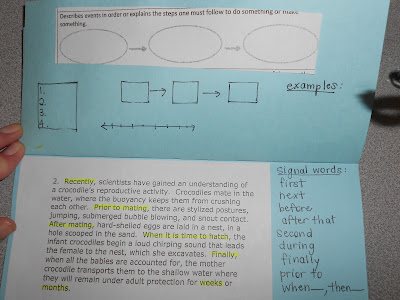As we continue in our journey exploring nonfiction, we dig beneath the
features of the text (captions, photographs, text boxes, maps, charts, diagrams, labels, glossaries, indexes, etc.) and begin to uncover the
structure of the piece. Even though all nonfiction pieces are written to inform us about a topic, some authors decide to build the text in a certain way, based on
exactly what they are trying to teach us. Take for example our sample paragraphs in our foldable, about crocodiles. An author could teach us about crocodiles by:
describing them,
sequencing their mating process in time order,
cause and effect of relationships between crocodiles and crocodile birds,
problems and solutions for the hunting of crocodiles, and/or
comparing and contrasting crocodiles to other classifications of crocodiles like caimans and gavials. These are known as the five different
nonfiction text structures.
 |
| We made foldables to help us learn the differences between each structure! |
Sometimes, an author may choose to use more than ONE text structure in their piece. In a book about Wildfires, the author may teach you about them by giving you a description of what they are in the first section. Then, they may show you the chronological order of events that happens during a wildfire. In another section, they might give you all of the effects of a wildfire. The way we decide which structure an author is using is by looking for signal words. Next, we ask ourselves, "How did the author teach me about this topic?" and "How did they build their ideas?".
 |
These readers are highlighting signal words they find in their article. With the help of their
foldable and graphic organizers, they can determine the structure of the text.
Writers, how could this information we have learned about text structure help us when writing an informational piece?
Readers, why is it important to uncover the structure of a text? Why does it matter?
|





it is important to know the text structure bacause it will help us better understand the artical by knowing what organization.
ReplyDeleteashley